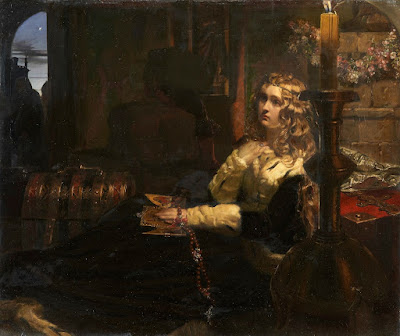 |
| David Roberts Gateway to the Great Temple at Baalbec 1841 oil on panel (diploma work) Royal Academy of Arts, London |
"David Roberts was the first independent British artist to travel and paint extensively in the Near East. His evocative portrayals of ancient monuments and vast deserts brought the topography of Egypt and the 'lands of the Bible' to an appreciative European audience. Roberts visited the site of the Great Temple at Baalbec in Lebanon on his first tour of the region in 1839 and described the daunting task of depicting a building of such 'magnificence that it is impossible to convey any idea, either by pencil or pen, of the beauty of its form, the exquisite richness of its ornament and the vast magnitude of its dimensions."
 |
| John Prescott Knight The Parting Blessing 1841 oil on panel (diploma work) Royal Academy of Arts, London |
"John Prescott Knight is best known as a portrait painter, initially studying at the Royal Academy Schools from 1823. His Diploma Work deals with the painful subject of the break-up of families in the 19th century, either because of emigration or because of the need of sons to join one of the armed services in order to seek their fortunes. Knight's ultimate decision to concentrate on the potentially more lucrative genre of portraiture may well have been due to lack of financial support after the death of his father."
"In 1843 Samuel Cousins was already an Associate Engraver (a category of membership since abolished) at the Royal Academy. In 1855 he became one of the first engravers elevated to full membership. His large mezzotint after C.R. Leslie's painting of an episode from Queen Victoria's coronation was displayed in the year of its creation at the Royal Academy Summer Exhibition."
"Herbert converted to Roman Catholicism in 1840 and spent the remainder of his career painting religious subjects and portraits of religious figures. Like Augustus Pugin and William Dyce, Herbert was keen to promote the revival of medieval liturgy, ritual and music. It is thus no accident that his Diploma Work depicts St Gregory, celebrated for promulgating 'Gregorian' chant."
"Webster trained at the Royal Academy Schools from 1821 and gained great popularity in his lifetime for scenes of rural life depicting cottage interiors. These genre paintings were widely reproduced as steel engravings. Like his contemporaries Mulready and Witherington, Webster offered a sanitized, reassuring rendition of the simple life."
"Omnia Vanitas, the Diploma Work submitted by William Dyce, alluded to the Victorian preoccupation with the 'fallen woman' – represented here in the guise of Mary Magdalen. The painter was a close friend of the prominent Liberal politician and future Prime Minister, William Ewart Gladstone, who began a campaign for the 'redemption' of prostitutes at around this time."
"The Outcast represents a fallen woman with her illegitimate child being evicted from her home by her stern father, despite the pleadings of the family. Redgrave studied at the Royal Academy Schools from 1826, initially specializing in conventional history painting and landscapes. Starting in the 1840s he began to depict contemporary melodramas, as here, and to feature unfortunate characters from modern life such as The Governess (1845) and The Sempstress (1846), highlighting the common plight of female workers."
"When first exhibited at the Royal Academy in 1858, Pickersgill's Diploma Work was accompanied by the following lines from a Spanish ballad: She tempted the Alcaydé with her jewels and her gold / And unto her his prisoner that jailer false hath sold."
"Trained in Paris, Philip Hermogenes Calderon became a founding member of the St John's Wood Clique, a society of artists interested in English historical subjects, particularly those of that most "romantic" era, the Tudors and Stuarts. Contemporary critics opined with a certain relish that the subject of Whither? might well have 'a tragedy for its ending."
"Thomas Faed was a Scottish artist trained at the Trustees' Academy in Edinburgh. He moved to London in 1852, where he specialised in genre scenes set in the Highlands. Though specific hardships are not depicted in Ere Care Begins, the artist hints at a difficult future for the child. Families of crofters were frequently evicted at this period to facilitate the grazing of large flocks of sheep."
– quoted texts adapted from Royal Academy notes
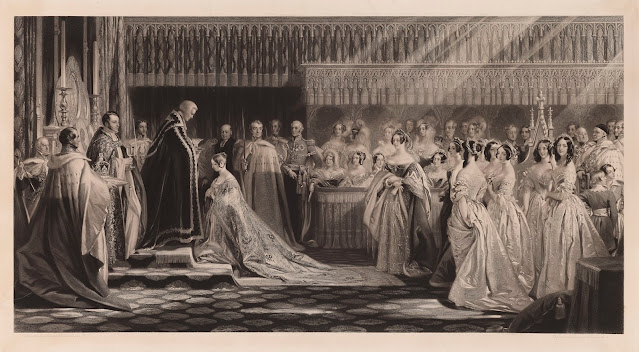 |
| Samuel Cousins after Charles Robert Leslie Queen Victoria receiving the Sacrament at her Coronation 1843 mezzotint (diploma work) Royal Academy of Arts, London |
"In 1843 Samuel Cousins was already an Associate Engraver (a category of membership since abolished) at the Royal Academy. In 1855 he became one of the first engravers elevated to full membership. His large mezzotint after C.R. Leslie's painting of an episode from Queen Victoria's coronation was displayed in the year of its creation at the Royal Academy Summer Exhibition."
 |
| John Rogers Herbert St Gregory teaching his Chant 1845 oil on canvas (diploma work) Royal Academy of Arts, London |
"Herbert converted to Roman Catholicism in 1840 and spent the remainder of his career painting religious subjects and portraits of religious figures. Like Augustus Pugin and William Dyce, Herbert was keen to promote the revival of medieval liturgy, ritual and music. It is thus no accident that his Diploma Work depicts St Gregory, celebrated for promulgating 'Gregorian' chant."
 |
| Thomas Webster The Early Lesson 1846 oil on canvas (diploma work) Royal Academy of Arts, London |
"Webster trained at the Royal Academy Schools from 1821 and gained great popularity in his lifetime for scenes of rural life depicting cottage interiors. These genre paintings were widely reproduced as steel engravings. Like his contemporaries Mulready and Witherington, Webster offered a sanitized, reassuring rendition of the simple life."
 |
| William Dyce Omnia Vanitas 1848 oil on canvas (diploma work) Royal Academy of Arts, London |
"Omnia Vanitas, the Diploma Work submitted by William Dyce, alluded to the Victorian preoccupation with the 'fallen woman' – represented here in the guise of Mary Magdalen. The painter was a close friend of the prominent Liberal politician and future Prime Minister, William Ewart Gladstone, who began a campaign for the 'redemption' of prostitutes at around this time."
 |
| Thomas Creswick Landscape with Artist resting beside a Road ca. 1851 oil on canvas (diploma work) Royal Academy of Arts, London |
 |
| Richard Redgrave The Outcast 1851 oil on canvas (diploma work) Royal Academy of Arts, London |
"The Outcast represents a fallen woman with her illegitimate child being evicted from her home by her stern father, despite the pleadings of the family. Redgrave studied at the Royal Academy Schools from 1826, initially specializing in conventional history painting and landscapes. Starting in the 1840s he began to depict contemporary melodramas, as here, and to feature unfortunate characters from modern life such as The Governess (1845) and The Sempstress (1846), highlighting the common plight of female workers."
 |
| Sydney Smirke Design for the Carlton Club, Pall Mall, London ca. 1855 drawing, with watercolor (diploma work) Royal Academy of Arts, London |
 |
| Frederick Richard Pickersgill The Bribe 1857 oil on panel (diploma work) Royal Academy of Arts, London |
"When first exhibited at the Royal Academy in 1858, Pickersgill's Diploma Work was accompanied by the following lines from a Spanish ballad: She tempted the Alcaydé with her jewels and her gold / And unto her his prisoner that jailer false hath sold."
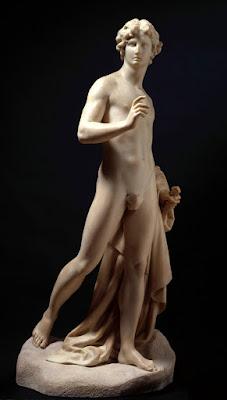 |
| John Foley The Elder Brother ca. 1858 marble (diploma work) Royal Academy of Arts, London |
 |
| George Gilbert Scott Design for the Foreign and India Offices, Whitehall ca. 1858 drawing, with watercolor (diploma work) Royal Academy of Arts, London |
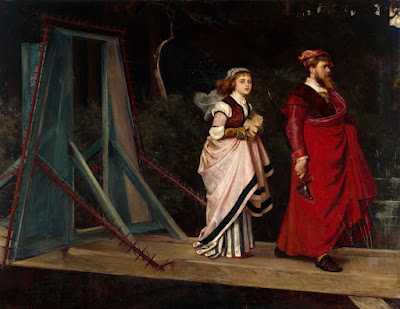 |
| Philip Hermogenes Calderon Whither? 1862 oil on canvas (diploma work) Royal Academy of Arts, London |
"Trained in Paris, Philip Hermogenes Calderon became a founding member of the St John's Wood Clique, a society of artists interested in English historical subjects, particularly those of that most "romantic" era, the Tudors and Stuarts. Contemporary critics opined with a certain relish that the subject of Whither? might well have 'a tragedy for its ending."
 |
| Frederick Goodall The Song of the Nubian Slave 1863 oil on canvas (diploma work) Royal Academy of Arts, London |
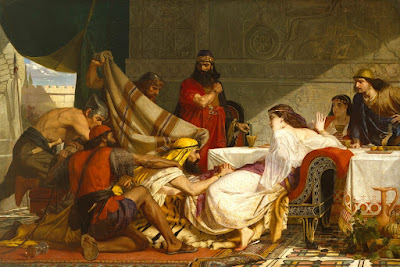 |
| Edward Armitage The Festival of Esther 1865 oil on canvas (diploma work) Royal Academy of Arts, London |
 |
| John Callcott Horsley A Pleasant Corner 1865 oil on canvas (diploma work) Royal Academy of Arts, London |
 |
| Thomas Faed Ere Care Begins 1865 oil on canvas (diploma work) Royal Academy of Arts, London |
"Thomas Faed was a Scottish artist trained at the Trustees' Academy in Edinburgh. He moved to London in 1852, where he specialised in genre scenes set in the Highlands. Though specific hardships are not depicted in Ere Care Begins, the artist hints at a difficult future for the child. Families of crofters were frequently evicted at this period to facilitate the grazing of large flocks of sheep."
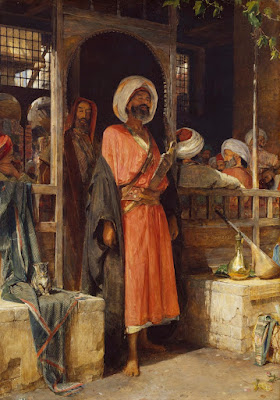 |
| John Frederick Lewis The Door of a Cafe in Cairo 1865 oil on canvas (diploma work) Royal Academy of Arts, London |
– quoted texts adapted from Royal Academy notes
